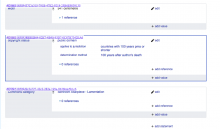We have this: We've recently implemented linking to specific statements via Property IDs for structured data on Commons, but the target statement UI block isn't highlighted, which is not quite an optimal user experience.
We want this:
ideally, statement blocks reached via anchor tag should be highlighted like they are in Wikidata.
Screenshots (if possible):
Example from Wikidata:
Acceptance Criteria:
- When file page URLs have anchor tags to a specific statement/property, highlight that statement block in the UI with a blue border of appropriate weight (doing it exactly like Wikidata is probably the best bet)
During development, please test the following:
- Test this feature while logged in AND logged out
- Test this feature on at least one mobile browser
COVID-19 Deployment Criteria
- Can you roll back this change without lasting impact?
- A recovery plan is required as this will help identify our capacity for recovering from the failure
- THIS IS A KEY QUESTION, if you can’t answer it, you shouldn’t deploy
- Is specialized knowledge required to support this change in production? If so, are there multiple people with this knowledge?
- Is there a way to increase confidence about the correctness of this change?
- Reviews (Design, Code, etc)
- Testing coverage (unit tests, integration tests)
- Manual testing (e.g. Beta, vagrant, docker)
